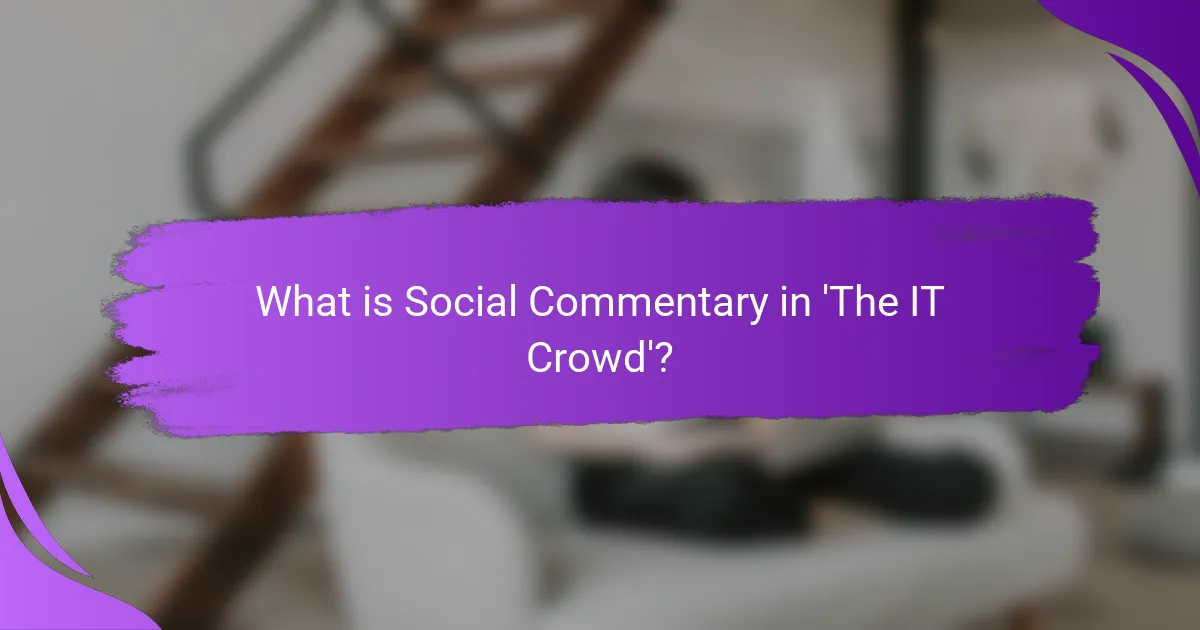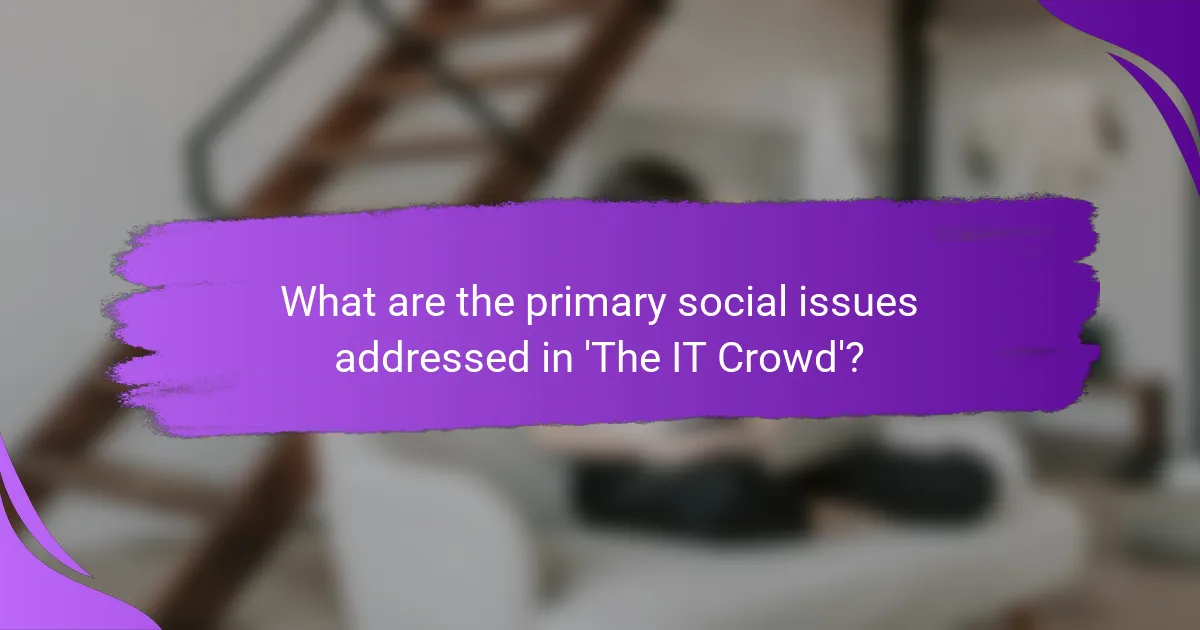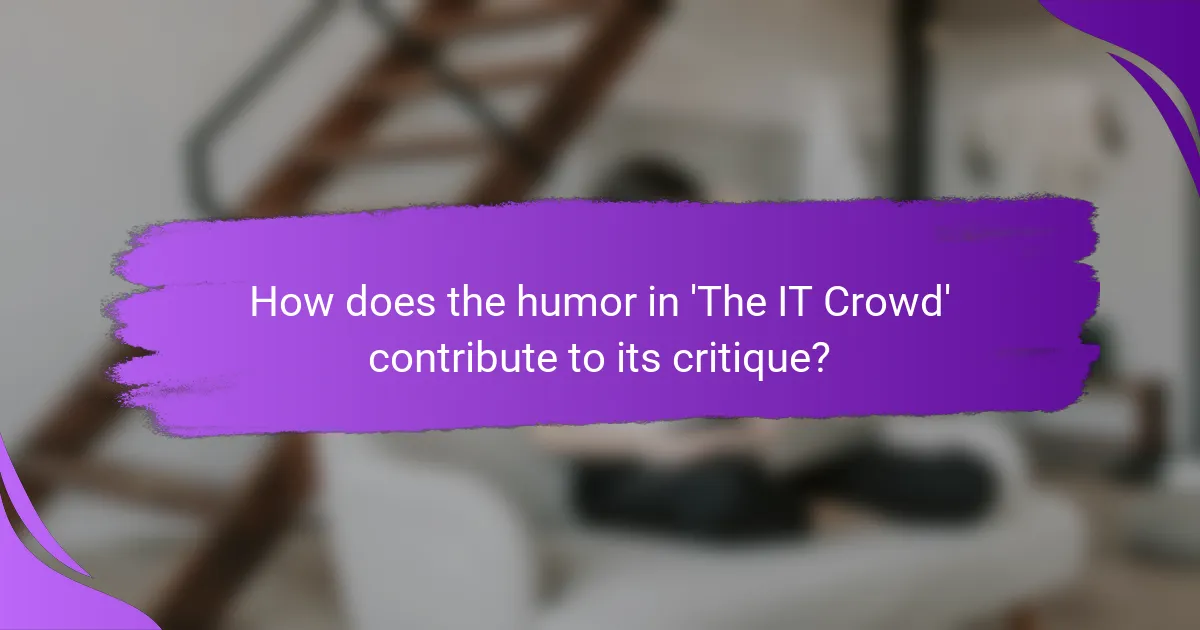The article examines social commentary in the television series ‘The IT Crowd,’ focusing on its critique of contemporary workplace culture and technology. It highlights how the show humorously addresses themes such as social awkwardness, corporate dynamics, and the absurdity of technology reliance. Key characters, including Moss and Jen, represent stereotypes within the tech industry, illustrating challenges like isolation and gender dynamics. The article analyzes how the series uses satire and irony to reflect societal norms, particularly in office environments, making its critique of workplace culture and technology dependence both accessible and engaging for viewers.

What is Social Commentary in ‘The IT Crowd’?
Social commentary in ‘The IT Crowd’ refers to the show’s critique of contemporary workplace culture and technology. The series humorously explores themes like social awkwardness, corporate dynamics, and the absurdity of tech reliance. Characters often embody stereotypes of the tech industry, highlighting issues such as isolation and incompetence. The show uses satire to reflect societal norms and behaviors, particularly in office environments. For example, the character Moss represents the socially inept tech worker, illustrating the challenges of communication in modern life. This blend of humor and critique provides insight into the absurdities of both technology and human interactions.
How does ‘The IT Crowd’ utilize humor for social critique?
‘The IT Crowd’ utilizes humor for social critique by satirizing workplace culture and technology reliance. The show portrays the absurdities of office life, highlighting the disconnect between IT professionals and non-technical staff. Characters like Moss and Roy represent stereotypes of tech workers, showcasing their social awkwardness. The humor often stems from misunderstandings and exaggerated situations, reflecting real societal issues. For instance, the show’s portrayal of corporate incompetence critiques management styles in modern workplaces. Additionally, it addresses themes of isolation and the impact of technology on personal relationships, using comedic scenarios to emphasize these critiques. This blend of humor and social commentary resonates with audiences familiar with similar experiences in their own workplaces.
What are the key themes of social commentary in the show?
The key themes of social commentary in ‘The IT Crowd’ include workplace culture, technology’s impact on society, and social awkwardness. The show critiques the absurdities of corporate life, highlighting the disconnect between employees and management. It also explores how technology shapes human interactions and relationships. Characters often face social challenges, reflecting real-life struggles with communication and acceptance. The humor serves to underscore these themes, making the commentary both entertaining and thought-provoking. These themes resonate with audiences, as they reflect contemporary societal issues.
How does humor enhance the effectiveness of these themes?
Humor enhances the effectiveness of social commentary themes in ‘The IT Crowd’ by making critiques more relatable. It allows audiences to engage with serious topics without feeling overwhelmed. Laughter can disarm viewers, making them more receptive to underlying messages. The show uses absurdity to highlight societal issues, creating a memorable impact. Humor also fosters connection among characters, reflecting real-life interactions. Studies indicate that humor can increase retention of information, aiding in the delivery of critiques. For instance, a study by the University of California found that humor improves message recall by up to 50%. Thus, humor serves as a powerful vehicle for social commentary in the series.
Why is plot development essential in conveying social commentary?
Plot development is essential in conveying social commentary because it structures the narrative to highlight societal issues. A well-developed plot allows for the gradual unfolding of themes and character arcs. This progression enables the audience to engage with the social critique being presented. In ‘The IT Crowd’, plot twists and character interactions serve to reflect real-world social dynamics. For instance, the show’s humor often critiques workplace culture and technology reliance. This integration of plot and commentary enhances the impact of the message. As characters navigate their challenges, viewers gain insight into broader societal norms. Thus, effective plot development is crucial for delivering meaningful social commentary.
What role do character arcs play in plot development?
Character arcs are essential for plot development as they illustrate a character’s transformation over time. These arcs create emotional engagement for the audience. They provide a framework for the narrative structure, guiding the plot’s progression. As characters face challenges, their decisions drive the story forward. This interaction between character growth and plot events enhances thematic depth. In ‘The IT Crowd’, character arcs contribute to humor by juxtaposing personal growth with absurd situations. This dynamic fosters social commentary, highlighting the contrast between individual experiences and broader societal norms. Overall, character arcs are crucial in shaping both the narrative and its underlying messages.
How do specific episodes illustrate social commentary through plot twists?
Specific episodes of ‘The IT Crowd’ illustrate social commentary through plot twists by subverting audience expectations. For example, in the episode “The Work Outing,” the twist reveals that the main character, Moss, ends up in a situation that critiques societal norms about dating. This unexpected turn highlights the absurdity of social interactions in a humorous way. Additionally, the episode “The Internet Is Coming” features a plot twist involving a fictional crisis that satirizes the panic surrounding technology failures. These twists effectively convey deeper messages about modern life and technology’s impact on society. The humor in these scenarios serves as a vehicle for critique, making the commentary both engaging and thought-provoking.

What are the primary social issues addressed in ‘The IT Crowd’?
‘The IT Crowd’ primarily addresses issues of workplace culture and gender dynamics. The show satirizes the tech industry’s stereotypes and the isolation often felt by IT professionals. It highlights the struggles of women in male-dominated fields, exemplified by the character Jen, who faces challenges in gaining respect. Additionally, the series critiques social awkwardness and the impact of technology on personal relationships. The humor in the show often stems from these social issues, making them accessible to a wide audience.
How does the show reflect workplace culture and technology?
The show reflects workplace culture and technology by showcasing the dynamics of a modern office environment. It highlights the absurdities of corporate culture, emphasizing issues like hierarchy and communication breakdowns. The characters represent various archetypes found in tech workplaces, such as the socially awkward employee and the oblivious manager. Technology is portrayed as both a tool for productivity and a source of frustration, illustrating the dual nature of digital advancements. The show’s humor often stems from the characters’ interactions with technology, revealing the challenges of adapting to rapid changes. For example, the reliance on outdated systems contrasts with the expectation for innovation. This juxtaposition serves as a critique of how organizations often fail to keep pace with technological progress. Overall, the show provides a satirical lens on the intersection of workplace culture and technology.
What stereotypes are challenged in the portrayal of IT professionals?
The portrayal of IT professionals in ‘The IT Crowd’ challenges several stereotypes. It subverts the image of IT workers as socially awkward and isolated individuals. The characters are depicted as relatable and humorous, engaging in social interactions and friendships. Additionally, the show challenges the notion that IT professionals lack creativity. Characters demonstrate innovative problem-solving skills and engage in imaginative scenarios. Furthermore, it contests the stereotype of IT being a male-dominated field. Female characters, like Jen, are portrayed as competent and integral to the team. This representation provides a more nuanced view of the IT profession.
How does the show address gender dynamics in the workplace?
The show addresses gender dynamics in the workplace by portraying the challenges faced by female characters. It highlights the disparity in treatment between male and female employees. For example, the character Jen Barber often confronts sexism and stereotypes in her role as a manager. The show uses humor to critique these dynamics, making them accessible to viewers. Specific episodes showcase Jen’s struggles to be taken seriously in a male-dominated environment. These portrayals reflect real-world issues of gender inequality in the tech industry. By blending comedy with social commentary, the show effectively raises awareness of these important topics.
What critiques does ‘The IT Crowd’ offer about modern society?
‘The IT Crowd’ critiques modern society by highlighting issues like workplace culture and technology dependence. The show satirizes corporate environments, showcasing the absurdity of office politics. It portrays IT professionals as socially awkward, reflecting stereotypes about tech workers. The series comments on the disconnect between technology and human interaction. Characters often struggle with basic social skills, emphasizing the impact of digital communication. Additionally, it critiques the overreliance on technology, suggesting it complicates rather than simplifies life. The humor in these critiques serves to underscore serious societal observations, making viewers reflect on their own experiences.
How does the show tackle issues of social isolation and connection?
The show addresses social isolation and connection through its characters’ interactions and situations. The main characters often experience loneliness in their work environment. Their quirky personalities highlight the struggle for meaningful connections. Humor is used to illustrate the absurdity of their social challenges. For example, the character Moss often feels out of place and disconnected. The show contrasts his experiences with those of more socially adept characters. This juxtaposition emphasizes the difficulty of forming relationships in a tech-driven world. Overall, the show uses comedy to critique social isolation while promoting the importance of connection.
What commentary is made about consumerism and technology dependence?
The commentary made about consumerism and technology dependence in ‘The IT Crowd’ critiques the excessive reliance on technology. The show portrays characters who struggle with basic social interactions due to their immersion in technology. This dependence leads to absurd situations that highlight the negative impact of consumer culture. For instance, the character Roy often prioritizes technology over personal relationships. The humor derived from these scenarios underscores the absurdity of modern consumer habits. The series suggests that technology, while beneficial, can also hinder genuine human connection. This duality reflects broader societal concerns regarding consumerism and its effects on personal well-being.

How does the humor in ‘The IT Crowd’ contribute to its critique?
The humor in ‘The IT Crowd’ serves as a vehicle for social critique by highlighting absurdities in corporate culture and technology reliance. The show’s comedic situations often exaggerate real-life scenarios in office environments. For instance, the character Moss’s social ineptitude reflects the struggles of tech professionals in a non-technical world. This humor underscores the disconnect between IT workers and their colleagues. Additionally, the show’s use of irony critiques the incompetence of management. Characters like Jen often find themselves in ridiculous situations due to their lack of understanding of technology. This dynamic satirizes the corporate hierarchy and its misunderstandings of IT roles. Overall, the humor effectively exposes the flaws in workplace culture and technology dependence, making the critique accessible and engaging for viewers.
What types of humor are prevalent in the show?
The show features several prevalent types of humor, including situational, character-based, and absurdist humor. Situational humor arises from the awkward and unexpected scenarios faced by the characters. Character-based humor relies on the distinct personalities and quirks of the main characters, such as Moss’s social ineptitude and Roy’s cynicism. Absurdist humor is evident in the surreal and illogical situations that defy conventional reasoning. This blend of humor effectively critiques societal norms and workplace culture. The show’s comedic approach has garnered critical acclaim, as evidenced by its ratings and fan following.
How does slapstick humor serve the narrative?
Slapstick humor serves the narrative by providing comedic relief and enhancing character dynamics. It creates exaggerated situations that highlight the absurdity of everyday life. This type of humor often underscores social commentary by illustrating the flaws of modern society. For example, physical comedy in ‘The IT Crowd’ emphasizes the incompetence of characters in a corporate environment. Such scenes engage the audience while critiquing workplace culture. The humor often leads to memorable moments that reinforce character relationships. Additionally, it allows for the exploration of serious themes through a lighthearted lens. Overall, slapstick humor plays a crucial role in driving the plot and delivering critiques effectively.
What role does irony play in the show’s social commentary?
Irony serves as a critical tool in the show’s social commentary. It highlights the absurdities of modern life and workplace culture. Characters often find themselves in situations that contradict their expectations. This contrast exposes societal norms and behaviors to scrutiny. For example, the show’s portrayal of tech support reveals the disconnect between technology and human interaction. By using irony, the show critiques the over-reliance on technology in everyday life. This approach encourages viewers to reflect on their own experiences. Irony thus deepens the show’s commentary on contemporary issues.
How can viewers interpret the humor as a form of critique?
Viewers can interpret humor as a form of critique by recognizing its role in highlighting societal issues. Humor often exaggerates flaws in characters or situations to provoke thought. In ‘The IT Crowd’, comedic elements expose workplace absurdities and social norms. This method encourages audiences to reflect on the underlying messages. For example, the portrayal of IT professionals challenges stereotypes while critiquing corporate culture. Such humor can prompt discussions about the realities of modern work environments. Additionally, satire within the show serves to critique technology’s impact on human interaction. Thus, humor becomes a vehicle for social commentary, allowing viewers to engage critically with the content.
In what ways does humor disarm serious topics?
Humor disarms serious topics by creating a safe space for discussion. It lowers defenses, allowing individuals to engage with difficult subjects. Humor can diffuse tension, making conversations more approachable. It encourages openness and vulnerability in dialogue. Studies show that laughter triggers the release of endorphins, promoting a sense of well-being. This physiological response can make serious discussions feel less threatening. Additionally, humor often reveals absurdities in serious situations, prompting reflection. By highlighting contradictions, humor enables deeper understanding and critique.
How can humor lead to deeper conversations about social issues?
Humor can facilitate deeper conversations about social issues by providing a safe space for discussion. It allows individuals to address sensitive topics without the weight of seriousness. This can reduce defensiveness and open up dialogue. For example, comedians often tackle social issues in their routines. Their humor can highlight absurdities and provoke thought. Studies show that humor can increase receptiveness to new ideas. It can also encourage empathy by making difficult subjects more relatable. In ‘The IT Crowd’, humor is used to critique societal norms. This approach prompts viewers to reflect on their own perspectives.
What practical insights can be drawn from ‘The IT Crowd’ regarding social commentary?
‘The IT Crowd’ offers practical insights into social commentary by highlighting workplace dynamics and technology’s impact on society. The show satirizes the stereotypes of IT professionals, portraying them as socially awkward yet brilliant. This reflects broader societal views on technology and its users. The characters often face absurd situations that critique corporate culture and management inefficiencies. For example, the character Moss’s lack of social skills juxtaposed with his technical expertise illustrates the disconnect between technology and human interaction. Additionally, the show’s humor addresses gender roles and diversity in the workplace, as seen in the character Jen’s struggles for respect in a male-dominated environment. This blend of humor and critique encourages viewers to reflect on their own experiences in similar settings. Overall, ‘The IT Crowd’ uses comedic elements to provide commentary on contemporary social issues, making its insights both entertaining and thought-provoking.
How can writers effectively use humor in social critique?
Writers can effectively use humor in social critique by employing satire and irony. Satire allows writers to highlight societal flaws through exaggeration. Irony enables them to reveal contradictions in social norms or behaviors. These techniques create a comedic effect while delivering a serious message. For example, in ‘The IT Crowd’, characters often embody stereotypes that are humorously exaggerated. This approach encourages audiences to reflect on the absurdity of these stereotypes. By making the critique entertaining, writers engage a wider audience. Humor disarms resistance to the critique, making it more palatable. Ultimately, effective humor in social critique fosters both laughter and critical thought.
What lessons can be learned about addressing serious topics in entertainment?
Addressing serious topics in entertainment requires a careful balance of humor and sensitivity. Effective storytelling can engage audiences while promoting awareness. Humor can serve as a vehicle for critique, making difficult subjects more approachable. For instance, ‘The IT Crowd’ uses comedy to address workplace culture and social dynamics. This approach can reduce stigma around serious issues. However, creators must remain mindful of their audience’s perspectives. Missteps can lead to trivialization of important topics. Successful examples show that thoughtful integration of humor can foster dialogue and understanding.
The main entity of this article is ‘The IT Crowd,’ a television series known for its social commentary on workplace culture and technology. The article examines how the show utilizes humor to critique contemporary issues such as social awkwardness, corporate dynamics, and the impact of technology on personal relationships. Key themes include the portrayal of stereotypes in the tech industry, gender dynamics, and the absurdities of modern office life. Additionally, the article discusses the role of plot development and character arcs in delivering effective social critique, highlighting how humor serves as a vehicle for deeper conversations about societal norms and behaviors.